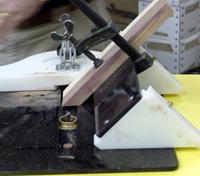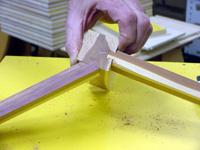Dovetail Joints Using The Mitre Gauge.
The Oak Park Mitre Gauge system is used in conjuction with a table mounted router to make a variety of wood joints. Today we will focus on dovetail joining a table rail to a square leg post both at a 90 degree and 45 degree angle.
Project Planning
This discussion will center on the proper set up to cut tight fitting dovetail joints. We will be using 3/4" thick material for the rails and square material for the leg.
The mitre gauge has a 1" wide slot that fits over a 1" diameter guide in a table mounted router. A combination 90 degree / 45 degree pin fence fits into index holes on the mitre base to cut dovetail pins using a 14 degree 1/2" dovetail bit. If your material is undersized or oversized you still end up with a 1/2" wide dovetail pin because of the indexed holes. However the pin will NOT be centered on the end of your material.
Dovetail Test Cut
First things first! Always, always make a sample cut prior to using the project material. The only thing that affects a proper fit is the height of the bit.
Set the bit height to 3/8" using the brass bar as a guide and you are ready to run a sample test cut. Clamp the material over the slot and cut a dovetail groove.
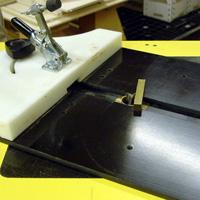
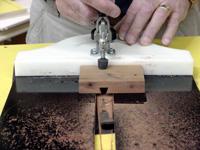
Next, clamp the 3/4" thick material to the 90 degree pin fence and cut the dovetail pin using the index holes on the RIGHT HAND SIDE of the mitre base. The material must be clamped to the pin fence and firmly held down during the cutting. Make certain you move the material into the cutting side of the bit. There may be some tear out because of the cutting angle of the bit. I have found that a piece of masking tape on the material and moving slower while cutting helps to reduce tear out.
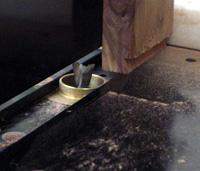
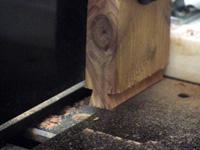
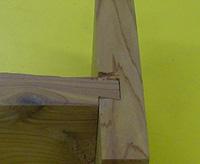
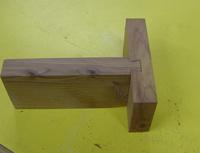
Slide the dovetail pin into the slot to check the fit. These are three possible outcomes 1) a perfect fit, 2) a loose fit or 3) a tight fit. If you come up with number 1, perfect. Numbers 2 and 3 are corrected by adjusting the bit height. The only two things to remember about proper dovetail joinery are heighten-to-tighten and lower-to-loosen. After any bit adjustment always run another test cut.
Cutting The Dovetail Slot
Now that the fit works great it's time to run the slot in the legs. We can turn the mitre gauge 90 degrees so that the head acts as a fence to the right hand side of the bit. Mark the center of the slots on the top of the leg and adjust the mitre gauge so the bit is centered on the mark. Now clamp the mitre gauge to the top as shown.
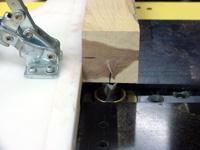
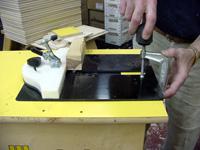
Measure the length of the dovetail slot and clamp a stop block in position so all the slots are the same length. NOTE: you will invariably get tear out while cutting the pins on the rails. Always pre-cut the rails wider than the desired finished width so they can be trimmed on the table saw to clean up the tear out. Keep this in mind when determining the length of the dovetail slot in the legs.
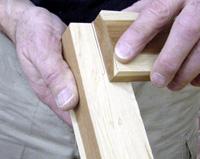
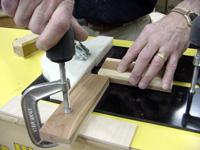
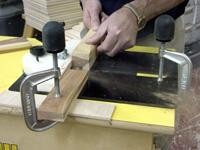
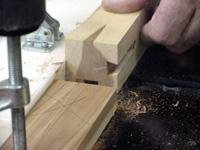
Cutting The 90 Degree Dovetail Pin
Clamp the material to the pin fence and repeat the cutting process decribed in the test cut procedure. Keep the material tight to the mitre base as you move into the cutting side of the bit. Check the fit of each pin before moving to the next cut.
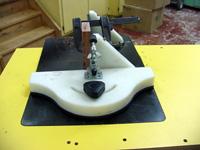
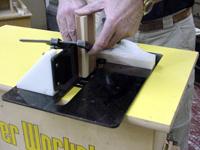
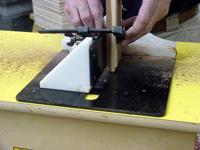
After the dovetail pins are all cut, rip the rails on the table saw to clean up any tear out. A small piece of the dovetail pin on the bottom of the rail must be trimmed off to allow the rail to slide past the dovetail groove on the leg for a clean look. Simply hold the rail material vertically against the mitre gauge head and take a little off with each pass. The bit will tend to pull the material to the right so take numberous small cuts until the top of the rail is flush with the top of the leg.
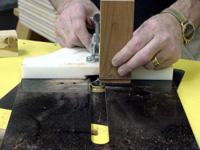
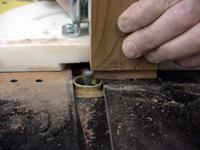
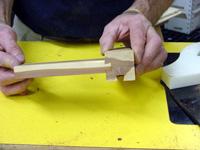
Cutting The 45 Degree Dovetail Pin
The mitre gauge pin fence also cuts 1/2" dovetail pins on the 45 degree end of 3/4" thick rail material. After cutting the end of the rail, clamp it to the 45 degree pin fence and use the index holes on the LEFT hand side of the mitre base. The first pass is made with the pin fence located in the OUTSIDE index holes, then stepped over to the INSIDE holes and pulled back toward the operator to make the second pass.
The dovetail bit tends to pull the material up so it MUST be clamped and held down firmly during the cut. Pressing a scrap piece of wood on the face of the rail helps to hold it in position.
